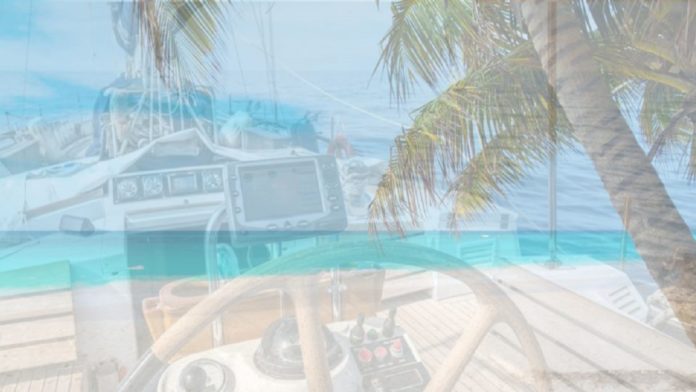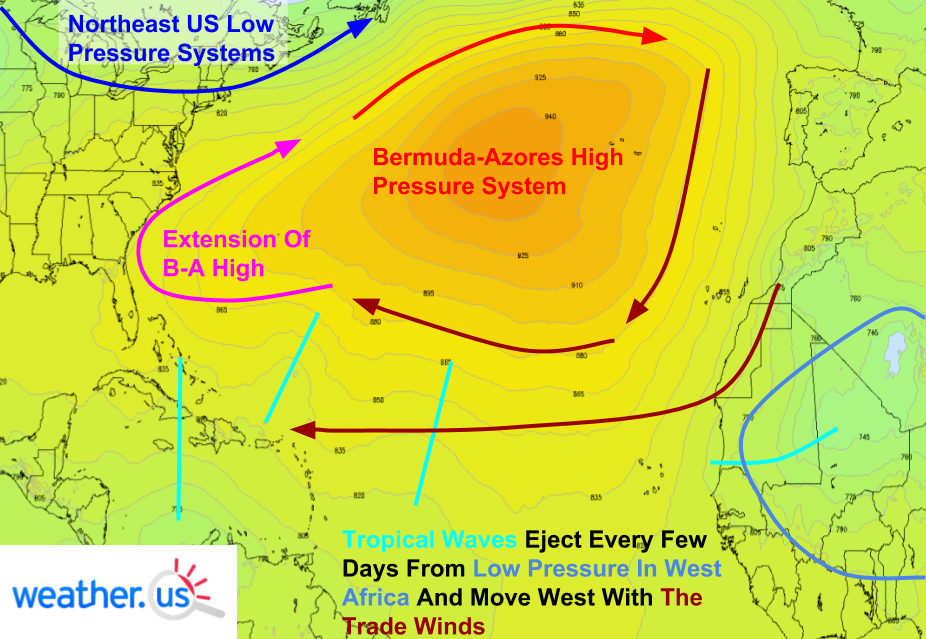
Countless boats sail the transatlantic route from the Caribbean to Europe each year, but you should not take navigation lightly because it must endure disturbances from the west moving east for up to 15-20 days. The traditional sailing ship path is called either an arch approach or possibly a stop in Bermuda simply to exit the trade wind system and enter the perturbations zone, where there would be enough wind. Let’s dive deep to know the sailing routes from the Caribbean to the Mediterranean.
Key points summarized
- Crossing the Atlantic from West to East is much harder than East to West
- The weather window is much shorter
- Your chances in being caught in bad weather conditions or no wind are high
- You need to be very experienced and well prepared
- 3 sailing routes are usually taken to cross the Atlantic Eastward
- Arch Route: Optimal for speed and reliability, heading around the north of the Azores High directly to the Azores.
- Two Stops Route: First stop at Bermuda, then proceeding to the Azores for resupply and favorable weather.
- Direct Route: For experienced cruisers only with sufficient fuel, heading straight to the Azores.
- Popular launch points for a transatlantic Eastward
- Bermuda
- BVI
- St Martin – Sint Maarten
Why crossing the Atlantic from the Caribbean to the Mediterranean isn’t the same as the Mediterranean to the Caribbean?
By early summer, the Caribbean’s prime season is winding down, pushed out by a barrage of large regattas. Then, when summer returns to the northern latitudes, the workers return home.
While most people concentrate on traversing the Atlantic from Europe to the Caribbean, the journey back to Europe or the east coast of the United States is as or perhaps more significant. The return trip may be more difficult, but it is also more diverse, and you should begin arranging for it as soon as you decide to go on a season abroad. The return path is well-traveled but presents a different situation than the way out. As a crew travels northeast, the days will grow longer, but temperatures will drop, and the climate can be highly variable and occasionally challenging. What should you consider while preparing your crew and yacht, and what is the ideal route and strategy?
The Azores High or the Bermuda High dictates the wind direction and the weather in the Atlantic.

Winds from the east are blowing against the south side of the high, which has the power to push tropical systems further west. From the eastern Atlantic to the Caribbean Sea or even over to the Gulf of Mexico, these easterly winds can carry them. That implies the Bermuda high’s effects are so profound that a hurricane may proceed in any direction—westward toward Louisiana, eastward toward the East Coast, or anywhere in between.
Taking the same route as the Mediterranean to the Caribbean (or a very direct line) would mean sailing upwind against tradewinds.
The weather window to cross the West to East is much shorter and more volatile than East to West.
The predominant winds in the northern hemisphere, more especially in the United States, blow from west to east in accordance with the rotation of the Earth. As a result, storms follow the jet stream in that same direction, making the weather very volatile. Thus, we get a very short window to travel in this direction.
Your chances of navigating very calm waters are high around the Azores High
The air is circulated clockwise by the high-pressure block of the Azores High, which behaves anticyclonically. Due to this movement, African eastern waves are pushed away from coastal West Africa and into the Bahamas, Central America, and the Caribbean, along the southern edge of the Azores High. Therefore, the chances of navigating very calm waters are high around the Azores High.
The best routes to cross the Atlantic from the Caribbean to the Mediterranean
Use our Sailing Distance calculator here
The weather plays a significant role in determining when to set sail, the route to take, and which sails to bring. The primary priority is avoiding the storm season from June to November. Hence, most boats depart in late November to arrive before Christmas, even though the tradewinds are typically stronger in January.
However, it is like humans to test the limits; some crews always depart early to extend the season. The sooner you go, however, the more crucial it is to maintain an easterly trajectory before deciding on a westerly route. Late storms from the west make a route through the Cape Verde islands increasingly appealing. It reduces the time spent in possible storm zones and provides a southern escape route since hurricanes seldom track south of 10°N.
Most sailing routes try to cross the Atlantic above the Azores-Bermuda High and head to the Azores islands.
Early in the season, low-pressure systems are more likely to be located further south; if you head north, you’ll often encounter headwinds north of the Azores. As summer draws near, low-pressure systems have a tendency to drift further north, and the Azores High widens, resulting in lighter winds as you approach the Azores.
The arch route going around the north of the Azores high straight to the Azores (Horta): the fastest and most reliable route
A yacht undertaking the west-to-east trip will eventually be overtaken by at least one front, and perhaps more, due to weather systems spinning off the US East Coast that can produce lows and frontal systems that can stretch well south. Therefore, the goal is to catch and ride favorable winds as far as possible. To do this, most boats head for the Azores to halt before choosing the best time to continue on to Spain, Portugal, or up to the UK.
The two stops route: head first to the Bermudas, then to the Azores
The most well-liked launching places are St. Maarten and Tortola in the British Virgin Islands; both are conveniently located and suitable for provisioning, spare parts, chandlery, and repairs. However, many crews stop at Bermuda on their way to or from the Caribbean, and this is a particularly wise move if the wind patterns alter three to four days out. Crews can rest, replenish supplies, have fun in Bermuda, and wait for favorable weather to start the next leg.
Going directly into the North Atlantic High straight to the Azores: a potential route for cruisers and yachts with plenty of fuel only
For cruisers, it is typically preferred to travel in a southerly direction, staying south of the Gulf Stream in light winds and adding extra fuel and motoring as needed.
What are the best Caribbean islands to cross the Atlantic from West to East?
One of the most well-liked launching points is Tortola in the British Virgin Islands or St. Maarten because of its convenient locations, chandlery services, and superior provisioning. However, several crews make a stopover at Bermuda, which is an excellent choice if the prevailing winds alter three to four days before reaching the Caribbean. In Bermuda, crews may rest, resupply, explore the island, and await a window of favorable weather conditions for the next round.
Read also: BVI Hurricane Season – Everything You Have to Know
What is the best time of the year to cross the Atlantic from the Caribbean to Europe?
Some people consider an Atlantic crossing or circuit to take a full year. It starts with a trip from Europe to the Caribbean in late November or early December and the yacht circle back in Europe in April/May to start enjoying the Mediterranean again summer time.
There are valid reasons for this schedule, the most important being the hurricane season. So this spans from the start of June until the conclusion of November. Hurricanes can occur beyond the ‘official season,’ although uncommon; yet, the previous three years have all had named storms during May.
What does your yacht need to have to cross the Atlantic from the Caribbean to the Mediterranean?
You should include essential spares, like pump and autopilot components. Moreover, replace any you may have used after your Atlantic voyage. Spare parts transportation to the Azores may be challenging and time-consuming.
A thorough inspection of the rigging before departure is required. Your standing and running rigging will have already traversed thousands of bright, salty miles. Likewise, the returning transatlantic trip will need you to remain days at a time on a single tack, so anticipate chafing on sheets and halyards. A skilled rigging inspection could be well worth the investment. However, if you perform it yourself, examine every piece.
In addition to bringing additional gasoline in jerry cans or flexible tanks, don’t forget to stock up on engine fuel filters and Racor water separator filters to prevent fuel supply difficulties. On most crossings, you seldom use the engine. But, when the wind is low, it’s excellent to push through a wind hole and get into the wind on the other side; more gasoline offers you more alternatives. Consider purchasing a portable transfer pump since wrangling funnels and pouring fuel at sea are filthy and cumbersome tasks.
Read also: 10 Sailing Myths And Bad Advice You Shouldn’t Listen To
How long does it take to cross the Atlantic from West to East?
On average, you will spend between three and four weeks sailing across the Atlantic Ocean. However, it is possible to finish in two weeks if you are fortunate, find shortcuts, and have a speedy sailboat. If there is insufficient wind for one week or longer, it may take as long as a month.
How hard is the sailing experience of crossing the Atlantic eastward?
Before setting sail across the Atlantic Ocean, you should be knowledgeable of and well equipped for the following circumstances and dangers:
- A lengthy travel
- Large waves
- severe weather, such as hurricanes (depending on when you set sail)
- Collisions involving cargo ships and vessels
- Whales
How experienced do you have to be to cross the Atlantic from the Caribbean to the Mediterranean on your own?
Crossing the Atlantic requires a solid, well-equipped vessel and a great deal of sailing expertise and talent. You will require expertise in weather forecasting, awareness of weather conditions, and familiarity with charts and course planning.
Can you charter a yacht for a transatlantic sailing trip from the Caribbean to the Mediterranean?
Transatlantic voyages are not just unique but also exhilarating experiences altogether. For many sailors, crossing the approximately 2,850nm (Canaries) – 3,200nm (Western France) distance across the Atlantic is a “must do experience of a lifetime.” It is an amazing yacht charter journey of a lifetime. The most seasoned, daring, and keen sailors are invited to participate in this yacht charter experience if they want to challenge themselves or just go on a brand-new sailing adventure. After an Atlantic crossing, we can surely say that yacht charters are no longer the same. Take advantage of these exclusive yachting vacation packages right away.
You can pick the yacht charter as sailing catamarans between 40 – 62′ or sailing yachts between 40-65′. You can visit a range of amazing destinations such as Saint Thomas, Saint Martin, Barbados, Portugal or even Spain.
Read also: Five Easy Beginners-Friendly Sailing Trips And Destinations
Conclusion
The Caribbean to the Mediterranean sailing route is lengthy. But it is worthwhile to those who complete it to the other side. The pleasure and feeling of success you will feel after completing the crossing will more than compensate for the months of planning and the difficulties you will undoubtedly encounter on the way.

